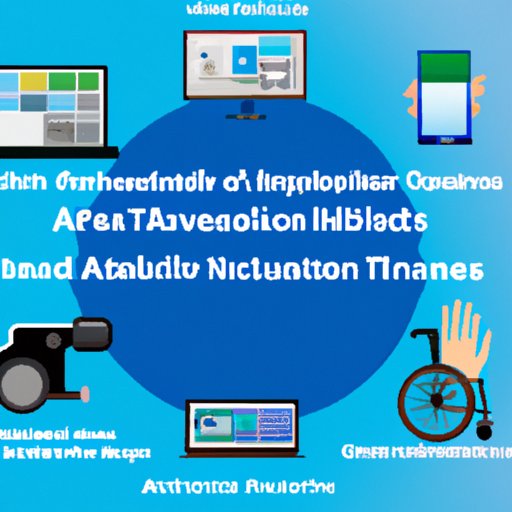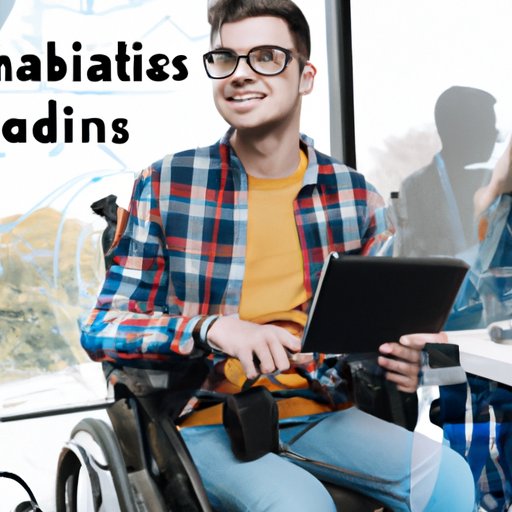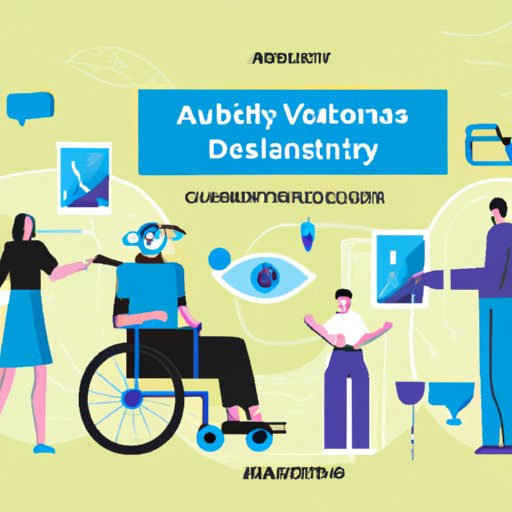Introduction
Assistive technologies are devices or software programs that help people with disabilities to live more independently. These technologies can be used to improve mobility, communication, vision, hearing, and other areas of life. They are designed to provide greater access to activities and services that may have been previously difficult or impossible for people with disabilities.
The purpose of this article is to provide a comprehensive guide to assistive technologies, covering the types of assistive technology available, resources for finding solutions, how to choose the right solution, and the latest innovations in the field. We will also explore the positive impact that assistive technologies are having on the lives of people with disabilities, as well as the benefits that these technologies can provide.
A Comprehensive Guide to Assistive Technologies
Assistive technologies come in many forms, from simple tools like canes and wheelchairs to sophisticated computer software and hardware systems. The type of assistive technology that is best suited to an individual’s needs will depend on the nature and severity of their disability, as well as their lifestyle and personal preferences.
Types of Assistive Technology
Assistive technology can be divided into three main categories: mobility and communication aids, vision aids, and hearing aids. Mobility and communication aids include items such as wheelchairs, walkers, and communication boards. Vision aids include magnifiers, reading machines, and Braille displays. Hearing aids include hearing amplifiers, cochlear implants, and alerting devices.
Resources for Finding Assistive Technology Solutions
There are many online resources that can help individuals find the right assistive technology solution for their needs. For example, the U.S. Access Board maintains a list of organizations that provide assistive technology services and products. Other resources include the American Foundation for the Blind and the National Association of the Deaf.
How to Choose the Right Assistive Technology Solution
When choosing an assistive technology solution, it is important to consider a range of factors such as cost, ease of use, compatibility with existing equipment, and user satisfaction. It is also important to consider how the device or software will fit into an individual’s daily routine and lifestyle. It may be helpful to speak to a professional who is experienced in the field of assistive technology in order to get advice about the best solution for an individual’s needs.

An Overview of Assistive Technology Solutions
In the following section, we will take a closer look at some of the most common types of assistive technology solutions.
Assistive Technology for Mobility and Communication
Mobility and communication aids can help individuals with physical disabilities to move around more easily and communicate more effectively. Examples of these aids include wheelchairs, walkers, canes, communication boards, and voice recognition software. These technologies can enable individuals to participate more fully in activities such as work, school, and leisure pursuits.
Assistive Technology for Vision
Vision aids can help individuals with visual impairments to better access information and participate in activities. Examples of these aids include magnifiers, reading machines, and Braille displays. These technologies can make it easier for individuals to read print materials, navigate unfamiliar environments, and interact with others.
Assistive Technology for Hearing
Hearing aids can help individuals with hearing impairments to better understand speech and other sounds. Examples of these aids include hearing amplifiers, cochlear implants, and alerting devices. These technologies can make it easier for individuals to engage in conversations, follow directions, and participate in activities such as sports and music.
Other Assistive Technology Solutions
There are also many other types of assistive technology solutions available, such as computer access aids, environmental control systems, and adaptive switches. These technologies can help individuals with a variety of disabilities to better access and interact with their environment.
How Assistive Technologies are Changing Lives
Assistive technologies are having a profound impact on the lives of people with disabilities. They are providing greater access to activities and services that may have been previously difficult or impossible for individuals with disabilities.
Positive Impact on Quality of Life
Assistive technologies are improving the quality of life for people with disabilities by enabling them to participate more fully in activities such as work, school, and leisure pursuits. According to a study conducted by the World Health Organization, “people with disabilities who use assistive technologies report improved self-esteem, increased independence, and enhanced social participation.” (1)
Increased Accessibility for People with Disabilities
Assistive technologies are also increasing accessibility for people with disabilities by making it easier for them to access public spaces, transportation, and other services. For example, in the United States, the Americans with Disabilities Act (ADA) requires businesses and public facilities to provide accessible features such as ramps, elevators, and wheelchair accessible restrooms.
Improved Learning and Working Environments
Assistive technologies are also creating more inclusive learning and working environments for people with disabilities. For example, assistive listening devices can make it easier for individuals with hearing impairments to participate in classroom discussions and meetings, while text-to-speech software can enable students with learning disabilities to access written materials more easily.
The Benefits of Assistive Technologies for People with Disabilities
Assistive technologies are providing a range of benefits for people with disabilities, including increased independence, greater ability to participate in social activities, and improved health outcomes.
Increased Independence
Assistive technologies are enabling individuals with disabilities to live more independently. For example, voice recognition software is making it easier for people with physical disabilities to communicate, while environmental control systems are allowing people with mobility impairments to control lights and appliances in their homes without assistance.
Greater Ability to Participate in Social Activities
Assistive technologies are also providing individuals with disabilities with greater access to social activities. For example, video conferencing software is making it easier for people with visual impairments to connect with friends and family, while hearing aids are helping people with hearing impairments to participate in conversations.
Improved Health Outcomes
Assistive technologies are also leading to improved health outcomes for people with disabilities. For example, computer access aids are making it easier for individuals with physical disabilities to access healthcare information and services, while hearing aids are helping people with hearing impairments to detect dangerous sounds in their environment.

Exploring the Latest Innovations in Assistive Technologies
In recent years, there have been several innovative developments in the field of assistive technologies. These include artificial intelligence (AI) and machine learning, wearable technologies, augmented and virtual reality, and usability testing.
Artificial Intelligence (AI) and Machine Learning
AI and machine learning are being used to create more intelligent and intuitive assistive technologies. For example, AI-powered speech recognition software is making it easier for people with speech impairments to communicate, while machine learning algorithms are being used to develop smart glasses that can recognize objects and help individuals with visual impairments to navigate their environment.
Wearable Technologies
Wearable technologies are becoming increasingly popular for people with disabilities. For example, smart watches can track heart rate, activity levels, and sleep patterns, while fitness trackers can monitor physical activity and provide feedback to users.
Augmented and Virtual Reality
Augmented and virtual reality technologies are also being used to create immersive experiences for people with disabilities. For example, virtual reality headsets can be used to simulate real-world environments, while augmented reality applications can provide audio and visual cues to help individuals with visual impairments navigate their surroundings.

Usability Testing for Assistive Technologies
Usability testing is an important part of the development process for assistive technologies. This involves identifying user needs, evaluating performance and design, and assessing user satisfaction.
Identifying User Needs
Usability testing begins with identifying the user needs of individuals with disabilities. This involves understanding the challenges faced by users and developing an understanding of how the technology could be used to address those needs.
Evaluating Performance and Design
Once user needs have been identified, usability testing involves evaluating the performance and design of the assistive technology. This includes testing the functionality of the device or software, assessing the user interface, and determining how easy it is to use.
Assessing User Satisfaction
Finally, usability testing involves assessing user satisfaction with the assistive technology. This includes gathering feedback from users on their experience with the device or software and making changes based on their feedback.
Conclusion
In conclusion, assistive technologies are having a profound impact on the lives of people with disabilities. They are providing greater access to activities and services that may have been previously difficult or impossible for individuals with disabilities. They are also increasing accessibility for people with disabilities, creating more inclusive learning and working environments, and providing a range of benefits such as increased independence, greater ability to participate in social activities, and improved health outcomes. Additionally, the latest innovations in the field of assistive technologies, such as artificial intelligence and machine learning, wearable technologies, and augmented and virtual reality, are making these technologies even more accessible and effective.
Usability testing is an important part of the development process for assistive technologies, as it helps to ensure that the device or software meets the needs of users with disabilities. By engaging in usability testing, developers can identify user needs, evaluate performance and design, and assess user satisfaction.
Overall, assistive technologies are transforming the lives of people with disabilities and providing them with greater access to activities and services. As the field of assistive technologies continues to evolve, it is likely that these technologies will become even more accessible and effective in the future.
(Note: Is this article not meeting your expectations? Do you have knowledge or insights to share? Unlock new opportunities and expand your reach by joining our authors team. Click Registration to join us and share your expertise with our readers.)
